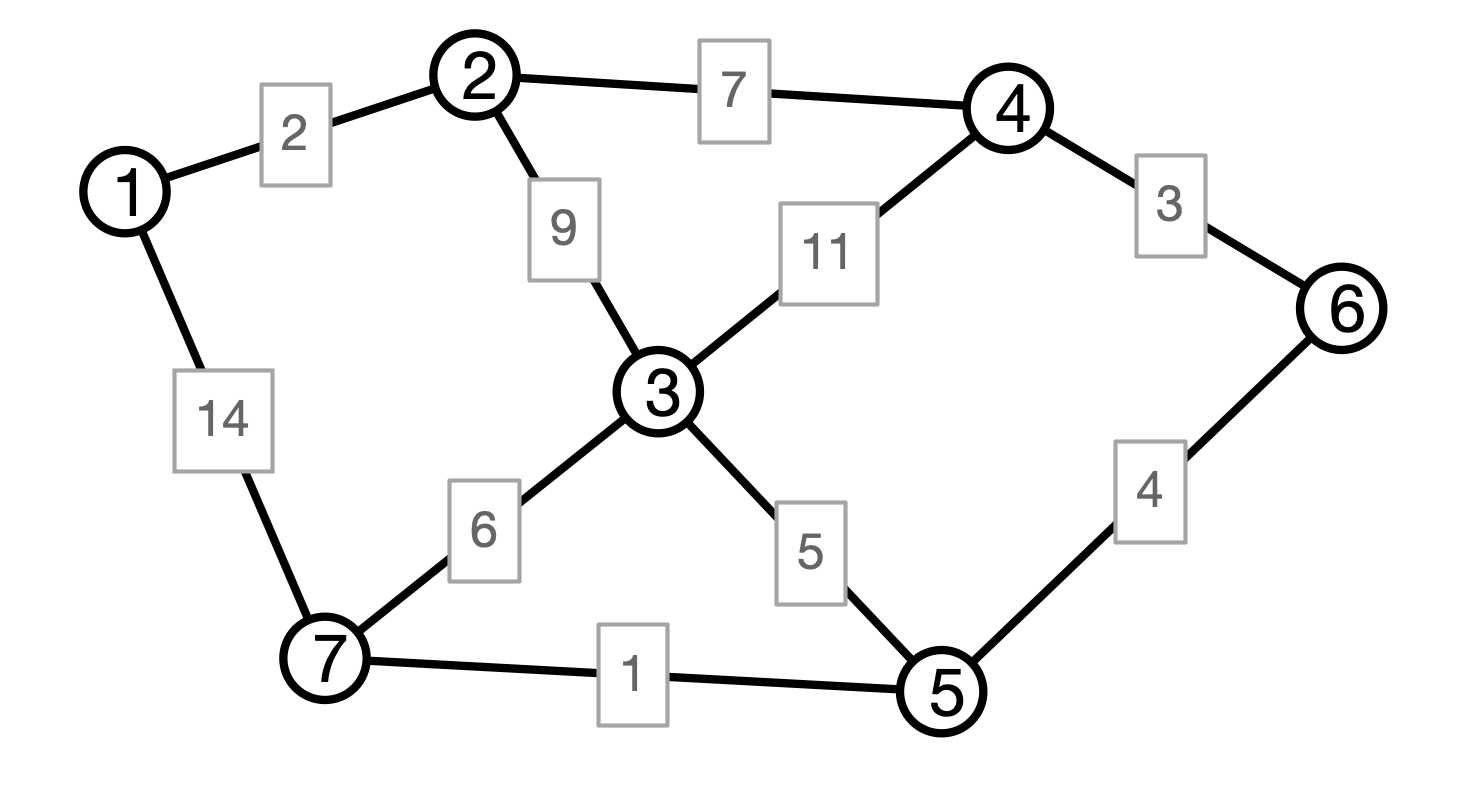Lecture 20: Minimum Spanning Trees, Part 3
COSC 311 Algorithms, Fall 2022
$
\def\compare{ {\mathrm{compare}} }
\def\swap{ {\mathrm{swap}} }
\def\sort{ {\mathrm{sort}} }
\def\insert{ {\mathrm{insert}} }
\def\true{ {\mathrm{true}} }
\def\false{ {\mathrm{false}} }
\def\BubbleSort{ {\mathrm{BubbleSort}} }
\def\SelectionSort{ {\mathrm{SelectionSort}} }
\def\Merge{ {\mathrm{Merge}} }
\def\MergeSort{ {\mathrm{MergeSort}} }
\def\QuickSort{ {\mathrm{QuickSort}} }
\def\Split{ {\mathrm{Split}} }
\def\Multiply{ {\mathrm{Multiply}} }
\def\Add{ {\mathrm{Add}} }
\def\cur{ {\mathrm{cur}} }
\def\gets{ {\leftarrow} }
$
Announcements
- Masks still required in class
- No class on Monday 10/24
- HW 03, Question 1:
- $n = 2^B$
- array contains $0, 1, \ldots, n - 1$ (not in order)
- values represented as $B$ bit numbers
- HW 03 now due Sunday
Last Time
Prim’s algorithm for Minimum Spanning Trees:
- Grow a tree from an arbitrary seed vertex
- Each step, add minimum weight edge out of tree
Cut Claim:
- if $T$ an MST, $U, V - U$ a cut, $e$ min weight cut edge
- then $T$ contains $e$
Prim correctness follows from cut claim
MSTs, Another Way
Prim:
- Grow tree greedily from a single seed vertex
- Maintain a (connected) tree
Edge Centric View:
- Maintain a collection of edges (not necessarily a tree)
- Add edges to collection to eventually build an MST
Questions:
- How to prioritize edges?
- How to determine whether or not to include an edge?
Picture

Kruskal’s Algorithm
Kruskal(V, E, w):
C <- collection of components
initially, each vertex is own component
F <- empty collection
# iterate in order of increasing weight
for each edge e = (u, v) in E
if u and v are in different components then
add (u, v) to F
merge components containing u and v
endif
endfor
return F
Kruskal Illustration

Kruskal Correctness I
Claim 1. Every edge added by Kruskal must be in every MST.
Why?
- Suppose $e = (u, v)$ added by Kruskal
- Consider the cut $U, V - U$ where $U$ is $u$’s component
- $e$ is lightest edge across the cut (why?)
- therefore $e$ must be in MST (why?)
Kruskal Correctness II
Claim 2. Kruskal produces a spanning tree.
Why?
Conclusion
Theorem. Kruskal’s algorithm produces an MST.
Next Question. How could we implement Kruskal’s algorithm efficiently? What is its running time?
Kruskal’s Algorithm
Kruskal(V, E, w):
C <- collection of components
initially, each vertex is own component
F <- empty collection
# iterate in order of increasing weight
for each edge e = (u, v) in E
if u and v are in different components then
add (u, v) to F
merge components containing u and v
endif
endfor
return F
Costly Operations
- Get edges in order of increasing weight
- Determine if $u$ and $v$ are in same component
- Merge two components
Question. How to get edges in order of increasing weight?
Maintaining Components
Idea. For each component, designate a leader
- leader is a vertex in its component
- maintain an array that stores each vertex’s component’s leader
-
leader[i] = v means that v is leader of i’s component
Question. How to check if vertices i and j are in the same component? Running time?
Merging Components
Question. How to merge two components?
Merging Components Efficiently?
For each leader, maintain list of vertices in its component.
To merge components with leaders $u$ and $v$:
- choose $u$ or $v$ to be leader of merged component
- if $u$ is new leader
- for each vertex $x$ on $v$’s list
- add $x$ to $u$’s list
- set $x$’s leader to $v$
Question. Running time?
Merging Strategy
When merging components with leaders $u$ and $v$, new leader is leader of larger component
Claim. If $x$ is relabeled $k$ times, then $x$’s component has size at least $2^k$.
Consequence
Claim. If $x$ is relabeled $k$ times, then $x$’s component has size at least $2^k$.
Consequence 1. If $x$’s component has size $\ell$, then $x$ was relabeled at most $\log \ell$ times.
Consequence 2. Running time of all merge operations in Kruskal is $O(n \log n)$
Conclusion
Theorem. Kruskal’s algorithm can be implemented to run in time $O(m \log n)$ in graphs with $n$ vertices and $m$ edges.
Remark. More efficient data structures for merging sets exist
- “Union-find” ADT, “disjoint-set forest” data structure
- time to perform merges is $O(n \alpha(n))$
- $\alpha(n)$ is “inverse Ackerman function”
- $\alpha(n)$ grows so slowly, it is practically constant
Next Time
- Interval Scheduling (recorded lecture)
